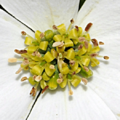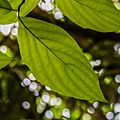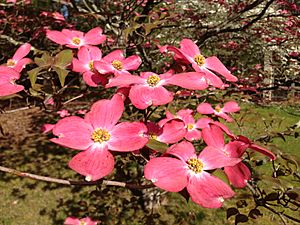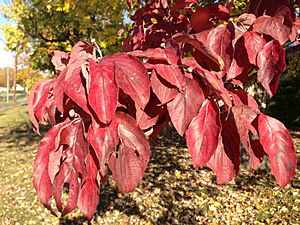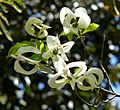Flowering dogwood facts for kids
Quick facts for kids Flowering dogwood |
|
|---|---|
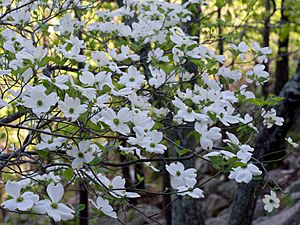 |
|
| Flowering dogwood in Spring | |
| Conservation status | |
| Scientific classification | |
| Genus: |
Cornus
|
| Species: |
florida
|
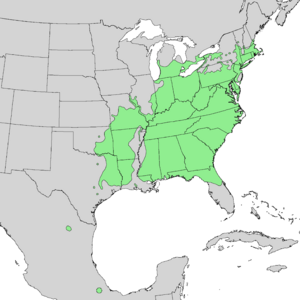 |
|
| Natural range of Cornus florida | |
| Synonyms | |
|
|
The flowering dogwood (Cornus florida) is a beautiful flowering tree found in eastern North America and northern Mexico. It's a popular tree often planted in yards and parks because of its bright, showy "flowers" and interesting bark. This tree used to grow naturally from Maine all the way down to Florida and west to the Mississippi River.
Contents
What is a Flowering Dogwood?
The flowering dogwood is usually called Cornus florida. Sometimes, people use other names like American dogwood or white dogwood.
There are two main types, or subspecies, of flowering dogwood:
- Cornus florida subsp. florida: This type grows in the eastern and south-central United States.
- Cornus florida subsp. urbiniana (Rose) Rickett: This type is found in northeastern Mexico, in areas like Nuevo León and Veracruz.
Description of the Dogwood Tree
The flowering dogwood is a small deciduous tree. This means it loses its leaves in the fall. It can grow up to 10 m (33 ft) (about 33 feet) tall. Often, it grows wider than it is tall. A 10-year-old tree is usually about 5 m (16 ft) (16 feet) tall.
Its leaves grow in pairs, one across from the other. They are oval-shaped, about 6–13 cm (2.4–5.1 in) (2.5 to 5 inches) long. In the fall, these leaves turn a beautiful red-brown color. A dogwood tree can live for about 80 years.
Dogwood Flowers and Fruits
The actual flowers of the dogwood are quite small and not very noticeable. They are greenish-yellow and have four tiny petals. About 20 of these small flowers grow together in a tight cluster.
What most people think of as the "flowers" are actually four large, colorful leaves called bracts. These bracts surround the real flower cluster. They can be white, pink, or even red. Each bract is about 3 cm (1.2 in) (1.2 inches) long and has a little notch at its tip.
Wild dogwood trees usually have white bracts. However, some special types grown in gardens have pink or even red bracts. Dogwoods typically bloom in early April in warmer areas and later in April or early May in cooler, higher places.
After the flowers fade, the tree produces bright red fruits. These fruits grow in clusters of two to ten. Each fruit is about 10–15 mm (0.39–0.59 in) (0.4 to 0.6 inches) long. They ripen in late summer and early fall.
These red fruits are an important food source for many types of birds. When birds eat the fruits, they help spread the seeds. The fruits are also food for several kinds of moths and butterflies. Even though they look pretty, the fruits are very sour and not good for humans to eat.
How to Grow a Flowering Dogwood
Flowering dogwoods grow best in moist, slightly acidic soil. They like some shade in the afternoon but plenty of sun in the morning. They don't do well in very hot places, like next to a parking lot. They also don't like salty soil.
If you plant a dogwood, make sure the soil drains well and is rich. It's a good idea to put a layer of mulch (like wood chips) around the base of the tree. This mulch should be about 5 to 10 cm (2 to 4 in) (5 to 10 cm) deep, but keep it away from the tree's trunk.
It's important to protect the tree from damage, especially from lawnmowers, as this can make it sick. You should also remove any dead branches or leaves each year. During dry periods, water the tree weekly in the morning, but try not to get the leaves wet.
Many different types of flowering dogwood have been developed for gardens. Here are a few popular ones:
- 'Appalachian Spring': Has large white bracts and red leaves in the fall. It's good at resisting a common disease called dogwood anthracnose.
- 'Cherokee Chief': Known for its red bracts and new leaves that also start out red.
- 'Cherokee Princess': A popular type with strong white bracts.
- 'Cherokee Sunset': Features purplish-red bracts and leaves with different colors (variegated).
Life Cycle and Reproduction
Flowering dogwood trees can be grown from seeds. The seeds are planted in the fall and sprout in the spring. For the seeds to grow well, they need to be kept cold for about 90 to 120 days.
Dogwood trees cannot fertilize themselves. This means they need pollen from another dogwood tree to make seeds. This is important for people who grow new types of dogwoods.
It's also possible to grow new dogwood trees from small pieces of branches, called cuttings. These cuttings are taken from new growth in late spring or early summer. Another way to grow specific types is by grafting, which means joining a piece of one tree onto the root of another.
Diseases of Dogwood Trees
One serious disease that affects dogwood trees is called dogwood anthracnose. It's caused by a type of fungus. If you have dogwood trees, it's good to know the signs of this disease and check your trees often. It's best to plant healthy trees and avoid moving trees from the wild, as they might carry diseases. Another problem can be root rot, caused by certain fungi.
Historical Uses and Fun Facts
Native Americans used the bark and roots of the dogwood tree to make medicine for malaria. They also used the roots to create a red dye.
The strong, hard wood of the dogwood tree has been used to make many things. These include golf club heads, mallets, tool handles, and even butcher's blocks.
The flowering dogwood is a special tree in several states:
- It is the state tree and flower of Virginia.
- It is the state tree of Missouri.
- It is the state flower of North Carolina.
Some people believe the tree got its name because its bark was used to treat dogs with mange.
In 1915, the U.S. sent 40 dogwood trees to Japan. This was part of an exchange where Japan had sent cherry blossom trees to Washington, D.C. in 1912. In 2012, the U.S. sent 3,000 more dogwood trees to Japan to celebrate 100 years of this friendship.
Images for kids
-
Dogwood trees in Nagano, Japan
See also
 In Spanish: Cornejo florido para niños
In Spanish: Cornejo florido para niños





